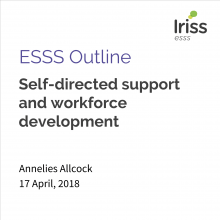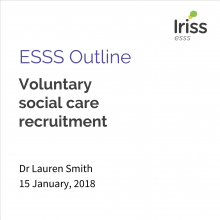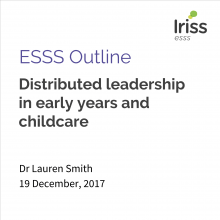Keith Quinn, Senior Education and Workforce Development Adviser with SSSC (Scottish Social Services Council), describes an e-learning model which uses the Sony PlayStation Portable (PSP) console to deliver on-the-spot training in the workplace. Markers (like a barcode) are inserted into training manual or materials. When the PSP is pointed at the marker it triggers a video to illustrate the learning point. The learner can proceed at his or here own pace and can review or revise at any time.
In this video Keith explains that the intention is to take the learning as close as possible to the point at which it is implemented. Not only does this remove the cost of travel to a central training location and minimise time away from work, it also makes the learning more effective by reducing the gap between the training course and the application of the learning.
The markers can also be attached to physical objects to provide usage instructions.
The PSPs were tested in a pilot project with Glasgow City Council with favourable reaction SSSC scoops top UK award for elearning.
Mobile Learning in the workplace - a cost effective approach to improving learning retention
June 2012
Transcript of video with Keith Quinn, Alice Gilligan and Thomas Gourlay, May 2012
Keith Quinn, Senior Education and Workforce Development Adviser, SSSC
Well we got the idea for the use of PSP for workforce development when I was at the Scottish Learning Festival, and a company called Connector Education were showing off the PSP, really for use in high schools - and I took one look at it and thought "there are so many applications of this for adult learning in the workplace". So we went away and kind of purchased the equipment and started looking at how we could apply it.
We know that it is becoming increasingly difficult to release staff for learning, mainly because backfill just isn't there: I mean the workforce isn't available to backfill any more, but also because there are legal minimums that people need to meet in terms of keeping people engaged in service delivery, when it comes to registration and regulation of service. So some of the core issues we wanted to address were the logistics of learning. So this whole thing about transporting people to a central location to learn and then transporting them back. When we spoke to employers they were saying to us that that costs, in real terms, £200 per day per employee. And even if organisations are delivering the minimum that we require in terms of ongoing registration needs which is 15 days over 3 years, that amounts to about £1,000 per employee. So over the entire workforce, that is £198,000,000 spent just on in-service training. If 20% of that moved to e-learning, or e-learning delivered on mobile devices in the workplace, that is a saving of £39,500,000, and it also addresses the thing about taking people out of the workplace in order to learn. And we did a research project on the back of this which kind of looked at how these logistics actually played out in the real world.
In terms of the research project that we ran, what we got back from line managers and learners themselves was that they loved the flexibility - they were able to fit the learning around shift patterns or around unforeseen demands. So for example, if you are delivering a classroom based course and there is a sudden issue at a workplace, what tends to happen is that the member of staff is called back to the workplace - but when you were using the PSP in the workplace itself, all they needed to do was switch off the PSP, go and attend to the issue, come back and then recommence their learning. So they are able to fit the learning around the workplace. It meant that they didn't have to travel across the authority - they were actually doing their learning in their own workplace, and both managers and learners said that they really valued that. The most interesting thing was that the learners felt that they had far more control over their learning in terms of pace and pace and place - they could choose. I don't think any one of them took it home - although we said that that was perfectly possible if they wanted to, but they all had the PSP for a full working week ... well actually more than that - Monday to Monday - as opposed to a one-day course which was run in parallel with the PSP group. None of them handed it back early, and we got lots of comments from learners about liking the fact that they could go back and revisit materials as often as they wanted to, until they were clear that they had got the learning point - something that they also reported they would be less likely to do in a group. So lots and lots of positives about actually dealing with the logistics, but even more important for us, lots of positives about the learning - because the whole point about the project for us was to look at the link between ... or look at the comparison between learning in a central location in a classroom setting, then taking the learning back to the workplace - and actually learning in the environment in which you are going to apply it. And again, the learners said that they found it much easier to apply the learning when they were using the PSP because they were actually doing the work in the place where they were going to apply the learning. So the whole premise of the project was "is this kind of a theory situated learning - does it have an impact?" And what we found was that it did very definitely have an impact.
The system works by using the PSP as a media player, and what it does is: the authoring system lets you associate what they call "markers", which are glorified barcodes with different types of media, and it uses the PSP camera to identify the marker and trigger the media. So there are two main ways you can use the system - one is to enhance print based materials - so you could take these barcodes and insert them into printed documents. The first time we saw it, it was being demonstrated with a tagged up version of a Shakespeare play, and you were able to point it at a marker and it would actually ... so if was Act 1, Scene 1, you would see the Royal Shakespeare Company actually acting out the scene before you read it yourself.
That is one way you can use it. The other way is to put the barcodes on the physical environment itself and use the work environment as the trigger for learning. So for example, you could put one of the codes on a drugs cabinet, a locked drugs cabinet in a residential unit for older people - then when you point the camera at it, you can have a video of somebody talking to you, a member of staff, saying "remember, when you take drugs out this cabinet you have got to fill in certain bits of paperwork - here is what that looks like - here is what you put in this part of the form or that part of form". So what you are doing is actually delivering the learning as you are applying it. So the idea there is to get the distance between learning and application as short as possible.
And the beauty is the device itself fits in a pocket, so what we were really keen on was e-learning with no interface, so people didn't have to sit and, you know, get over their anxiety about using a keyboard or a mouse or a track pad. I mean basically if you have got an opposable thumb it can press the X button - that's you good to go, because literally all you need to do is point the camera at one of the markers and the media plays. And you can construct whole programmes of learning, which we actually did with the research project - we took one of Glasgow City's courses, the "Violence and Aggression and Personal Safety at Work", and turned that into an annotated workbook which had the markers embedded in it, which allowed people to access rich media as they were learning. But also we are quite keen to explore how this system could be used for life skills development for service users - so they are all about supporting people in their own tenancies, people have a support worker allocated, the idea is that we would tag up somebody's home with the second site markers and it would almost be like having a virtual support worker when that support worker couldn't actually be there. The beauty is, you could have all the video assets and audio assets with that person's own support worker providing the face and the voice - so it's a known face, a known voice, in their own tenancy, and it's there to act as a reinforcer for the kind of hands-on work that the support worker would do with them. Also, we feel it could be used for training for assistive technologies - so if you are in an environment where you have got lifts that help service users get in and out of baths unaided, you could tag up that piece of equipment with the learner on how to use it and use the PSP as a permanent training resource, because usually when you buy equipment like that, the kind of standard deal is the company sends somebody in, they do a one-day session for staff, they go away. If you want them to come back, it tends to cost you. What we would say is use the PSP - get them to do it once, film them, and then you have got a permanent record of the training, you can tag up the equipment and actually do refresher training for any time the people want it.
I mean what I would say is it's not a magic bullet, you know, it's not something that you would use for all e-learning purposes, but I think it has a place, and it has a place in terms of delivering knowledge quickly, or delivering learning quickly in the workplace.
The feedback we got when we were doing the demonstration project was very, very positive. Managers loved the flexibility that the system offered - learners, managers ... and they liked the fact that they didn't have to send people across the authority to the training centre: it made the whole thing much, much more flexible for them. One manager was, you know, kind of even said that what they liked about it was there was no place to hide. So like what they meant was you couldn't turn up for a course and sit in the corner and coast all day, you know, it was you, the learner and the learning, and you had to get on with it. The fact that somebody was learning was much more visible in the workplace, because they were using it in the workplace. And for learners, they really loved the sense of control and ownership, so they felt they were in control of their learning - they could dictate the pace, they could remediate if they wanted to, they didn't have to feel embarrassed about asking a question because there was no group sitting around - they could actually kind of ask the question of their line manager, so it got the line manager more involved, or they could talk to peers. We had one ... in the demonstration project we had one workplace where there were two members of staff both using the system and they were able to bounce ideas off each other with that. So we got a lot of positive feedback from learners, and I must confess I ... you know, given our target demographic which is kind of 35 to 55, predominantly women, the group kind of reflected that demographic. And they are not the kind of typical group you think about using a hand held gaming device, so I expected a bit of resistance to using the technology - in the end, it just wasn't there. People loved using the PSP. It won a Guardian Public Service Award for Innovation and Progress in Skills Development, it won the Microsoft Prize for E-Learning at the University of Ulster, and it even got attention of folk like the Adobe Corporation who were very interested in how we had gone about creating the materials for it.
Alice Gilligan, Team Leader, Southbrae Resource Center
It was much quicker, it was less disruptive to the running of the Day Centre. It wasn't as time consuming. People sometimes tend to think "oh I'm away for a full day's training" - they would rather maybe not do it, especially if it is not something that was very interesting. Whereas the PSP caught people's imagination and thought "this is something ... this is good". And it was very positive feedback that we got, the staff that did it really enjoyed it.
Thomas Gourlay, Glasgow City Council, Social Work Services Training Section
We are always looking to find ways to engage nightshift staff in training - we see this as, again, another positive way of doing that - taking people off shift, bringing them in, changing their working patterns to do training during the day. I think those days are gone, so finding other ways to train staff that work at nights is, again, a very positive use. The study found that the people who used the PSP's did retain more information, through the short test that they did afterwards, and I think that's because they are doing the training in-situ, when are where they need it - they are able to put it into practice immediately, and that is the real benefit. In terms of that in-situ learning, when and where it's needed, it's priceless, and I think that is what it highlighted.
Keith Quinn
Well actually it's really cheap, which is what drew our attention to it. To buy a full kit, standard kit from Connected Education - a carry case, which also charges the devices, it includes 16 PSPs, cameras, memory sticks and the software, the authoring software to create the materials, the scripts - it's something like £3,500 to £4,000. And when we talked to training managers, they tell us that "well one course would pay for that - one day's training would pay for a whole kit". And the other thing was that the authoring system and delivery system is a closed system, so it's very easy - there is virtually no learning curve to either author or use the end product. So those were the main things that drew us to it, was its cost-efficiency.
I would like to see a larger number of organisations using the system, you know, I would like to get to the point where there was enough people using it that we could set up almost a user group on our Workforce Solutions portal [http://workforcesolutions.sssc.uk.] and actually have folk share scripts and digital assets, because like for instance Glasgow City Council did Violence, Aggression and Personal Safety. If somebody else did Food Hygiene - why can't we swap materials? And if we are able to host the scripts ... the script files and all the digital assets that go with it and people could upload and download from Workforce Solutions, that would be idea. So in a kind of Scottish context, that is what I would like to see, is kind of across the sector, people, you know, beginning to share materials and beginning to come together to solve problems, using the system. The research project we have done demonstrates that delivering learning in the workplace is more effective than sending everybody to a central location. What we hope to show folk is how to do that in a very cost efficient, simple manner.




